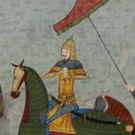Лидеры
Популярный контент
Показан контент с высокой репутацией 04/08/23 во всех областях
-
Д. чл. Мухамед Садыкович Рамеев в 1904 г. принес в дар музею Комиссии старинную рукопись на Джагатайском наречии, которую Комиссия переслала д. чл. проф. В. В. Бартольду с просьбой просмотреть рукопись и дать отзыв. Г. Бартольд с крайней любезностью исполнил просьбу Комиссии и отзыв его здесь помещается (см. также вып. XVI, стр. 45, прот. засед. 26 нояб. 1904 г.). С Джагатайского на русский перевод сделав д. чл. А. В. Васильевым и Г. Г. Балгимбаевым. "Аксак-темир происходил из рода Лас, приходясь племянником по женской линии одному из ханов. Вскоре по рождении родители его умерли и воспитывать его было не кому, он предоставлен был самому себе. Выросши, он ушел 32 в г. Шамаху, где и находился сначала без дела, а потом нанялся пасти телят" 32. В подлин. стоит: «казактан шыгыб, Шамгы шаарина барды». https://www.vostlit.info/Texts/Dokumenty/Zolotoord/XIII/1200-1220/Ist_cingiz_tamerlan/text1.htm2 балла
-
1 балл
-
Перешеек захлопнулся 12 тыс лет назад. Наши предки и индейцы выходили из одного амурского региона. Штаны появились до кочевничества в суровых условиях Сибири.1 балл
-
@АксКерБорж Никто не отрицает обратный феномен заимствования. Тот же самый русское "Капкан" является тюркизмом, которое в казахском метатезировалась в Қақпа. А очевидные заимствования на вроде "Шалвар",где фонетический "в" превратилось в "б" в казахском языке вы признавать не хотите из за аргумента, что другие народы ходили голой жопой или носили халат. А лингвистические аргументы вообще отрицаете.1 балл
-
@АксКерБоржто что у одного народа есть слово или нету для обозначения одной вещи не означает, что этой вещи у них не было. В деревне тюркском языке есть слово обозначающее штаны? Если нет, обозначает ли это то, что они ходили голым? Конечно нет1 балл
-
Пребывание мое в Астрахани доставило мне возможность собрать разные любопытные сведения. Первая орда, встречающаяся на восток от Волги, состоит из Татар Ногайских, походящих на Астраханских. За Уралом или Яиком живут три орды Киргизцев, которые, говорят, могут выставить до 150,000 всадников. — После Туркменцев Киргизцы самые дурные соседи, каких только можно иметь в Азии. Хотя часть сего народа признает владычество России, но частные люди часто сами ведут войну. Они переплывают Волгу или Яике, ведя лошадей своих за веревку, и горе Русскому, который попадется к ним в руки! Его отводят в Хиву и продают. Но и им платят тою же монетою; теперь в Астрахани человек тридцать пленных Киргизцев. Я сидел их [230] плоские лица; они составляют средину между Татарами и Калмыками, но выше ростом и сильнее сих последних. Каракалпаки или черные шапки составляют ныне орду уже не многочисленную и кочуют по берегам Аральского озера; они нанимаются в Хиве в поденщики. Хивинские Татары народ оседлый; у них есть постоянные деревни и главный город. Деревянные их домы выстроены хорошо; внутри смазаны и выкрашены. Хивинский Хан пленник в своем собственном замке и те, которые пользуются верховною властию, только действуют его именем; если им недовольны, то посылают его в Бухару и вызывают на его место другого. Набеги Киргизцев доставляют каждому семейству в Хиве по одному или по два Русских пленника; если сии последние согласятся сделаться Мусульманами, то их тотчас же освобождают. Говорят, что не многие из них на это решаются; те которые женятся увеличивают народонаселение и промышленность. Подробности сии сообщены мне одним Русским, который слишком двадцать лет был невольником в Хиве. В Астрахани всегда бывают купцы из [231] сего города; они приезжают в Россию так смело, как будто не нарушают всеобщего права покупая Русских невольников и поощряя таким образом Киргизцев к новым набегам. Я встречался со многими из них; они грубы и необходительны; от них много не узнаешь. Город Бухара сообщает тон всему Туркестану. Бухарский Хан, владетель могущественный и столь искусный, что основывает власть свою на Теократии, ибо всегда говорит именем Корана. Бухарцы, древние Согдиане, и теперь, как прежде производят всю торговлю в Верхней Азии. Они ездят за Индейскими товарами в Мультан, за Китайскими в Кашгар, за Русскими в Оренбург. Древнее имя их: Согдияне, весьма походит на слово Судахер, которое по Персидски, значит купец. Туркменцы, живущие по берегам Каспийского моря, также как и Киргизцы, народ совершенно кочующий; главная отрасль промышлености их есть грабительство; однакоже они производят некоторый торг в Мангишлаке, куда приходят для того Русские корабли; но никто не смеет выйти на берег, пока [232] они не дадут заложников; даже эта предосторожность не всегда бывает достаточна. — По сему весьма было бы опасно итти познавать этот народ в его собственной стране. Есть также Туркменцы подвластные России. https://www.vostlit.info/Texts/rus13/Potockij/text4.htm1 балл
-
Kazakhs While Muslim and Turkic speaking, the Kazakhs emerged as a people from the breakup of the MONGOL EMPIRE and have been in constant contact, both warlike and peaceful, with Oirats and Khalkha Mongols. Today they form Mongolia’s largest non-Mongol minority. ORIGINS The Kazakh aristocracy reckons its descent from ToqaTemür, the 13th son of CHINGGIS KHAN’s son JOCHI (d. 1225?). The descendants of Toqa-Temür seized power over the BLUE HORDE in modern Kazakhstan under Urus Khan (d. 1377) but were driven east by the Uzbeks (Özbegs) under the rival Shibanid line in the mid-15th century. Urus Khan’s descendants became qazaqs, “freebooters,” around the modern Xinjiang-Kazakhstan border. (Kazakh is simply the Russian pronunciation of qazaq, a term that also gave rise to the designation Cossack.) Under Qasim Khan (d. 1523) the Kazakhs rose to power again and eventually drove both the Uzbeks and the rulers of MOGHULISTAN south to the oasis cities of Mawarannahr (Transoxiana) and the Tarim Basin. Kazakh tribal and CLAN NAMES show their mixed origins. JALAYIR, Qunghrat, Manghit, Dughlat (Dogholad) and, of course, Chinggisid Qiyat clan names are of Mongolian origin (see BORJIGID, MANGGHUD, QONGGIRAD). The Nayman, Kerey, Qara-Qitay, Tangut, and Arghin (Arghun)clans are descended from conquered steppe peoples of the MONGOLIAN PLATEAU subjugated by the Mongols and brought west with the Mongol conquest (see KEREYID, NAIMAN, ÖNGGÜD, QARA-KHITAI, and XIA DYNASTY). QARLUQS, QIPCHAQS, and Qanglis were the native Turkish tribes of the area. Other tribal names are of obscure origin. The Kazakh language is a dialect of Common Turkish and shares with Tatar, Baskir (Bashkurt), and other Turkish languages of the Qipchaq family the change of initial y- to j- or zh- (thus zheti, “seven,” and zhïl, “year,” not yeti or yïl). WARS WITH THE OIRATS From their emergence in the 15th century the Kazakhs faced the OIRATS (whom they, like all Turkish peoples, called KALMYKS) on their eastern frontier. During the 16th century the Kazakhs pushed the Oirats north toward southern Siberia, but in the 17th century the Oirats conquered Züngharia (Junggar Basin) and the Ili Valley and attacked the Kazakhs. Under TSEWANG RABTAN KHUNGTAIJI (b. 1663, r. 1694–1727) and Galdan-Tseren (r. 1727–45) the Oirats’ Zünghar principality smashed the Kazakh confederation and drove the Kazakhs north and west in what was long remembered in Kazakh folklore as the “Barefoot Flight” (Aqtaban Shubirindi). By this time the Kazakhs were divided into three zhüz (100s, called “hordes” in Russian): the Great (Ulu) Zhüz in eastern and southeastern Kazakhstan, the Middle (Orta) Zhüz in central, northern, and southern Kazakhstan, and the Lesser (Kishi) Zhüz in western Kazakhstan.The wars with the Oirats left a strong impression on the Kazakhs, Kyrgyz, and other Islamic peoples of the Inner Asian steppes. The Kazakhs had become Muslim in the 14th century, and after the Oirats converted to a peculiarly militant form of Tibetan-rite Buddhism around 1580–1615, their conflict became not just a struggle for livestock, territory, and honor but also on both sides a religious war against unbelievers. In Kazakh and Kyrgyz epics the hero’s enemy is always a Kalmyk (i.e., Oirat). EXPANSION EAST As the Manchu QING DYNASTY (1636–1912) destroyed the crumbling Zünghar principality in 1752–59, Kazakhs migrated westward to occupy Oirat lands. The Ili Valley was settled by the Great Zhüz and the Zünghar (Junggar) Basin by the Kerey, Nayman, and Waq tribes of Middle Zhüz. The Qing dynasty granted the Kazakhs in Xinjiang titles as teizhi (from Mongolian TAIJI) and collected tribute from them. As Russia subdued and settled Kazakhstan from 1730 to 1864, more Kazakhs migrated into the less crowded Xinjiang pastures. The Kazakhs, having greater mobility, better weapons, and better Russian-language skills than did the XINJIANG MONGOLS, dominated border trading and smuggling. By 1862 Kerey Kazakhs of the Middle Zhüz first appeared in western Mongolia’s Khowd frontier. The Qing court granted them provisional recognition there in 1882. Legal disputes continued as the Kazakh population advanced at the expense of the indigenous ALTAI URIYANGKHAI. During the 20th century Kazakhs began moving into pastures in Barköl, Gansu, and even Qinghai on the Tibetan plateau. The Kazakhs generally kept the upper hand in frequent clashes with the original Oirat Mongolian inhabitants. In 1949 the new Chinese Communist administration began fixing separate settlements for the Kazakhs and the Mongol nomads. The Kazakhs’ higher birthrate continues to increase their share of the population even in Mongol autonomous units. KAZAKHS OF MONGOLIA In July 1912 a Kerey Kazakh leader, Sükirbay, on behalf of 400 families requested that the Kazakhs be allowed to stay in newly independent Mongolia. This request was granted and land set aside for a Kazakh banner in modern BAYAN-ÖLGII PROVINCE. Other Kazakh bands, however, continued to ignore the border between Mongolia and Xinjiang, now under the Republic of China, roughly defined in 1913. Even the recognized Kazakhs had tense relations with the local western Mongols, who accused them of horse theft and raiding. After Mongolia’s 1921 REVOLUTION the Kazakhs were organized into two banners. In 1940 Mongolia’s maximum leader, MARSHAL CHOIBALSANG, (r. 1936–52), after visiting KHOWD PROVINCE, created a new province, Bayan-Ölgii, in predominantly Kazakh areas. The provincial administrative council consisted of seven members, five Kazakh and two Altai Uriyangkhai. The new province facilitated Mongolia’s interventions as a Soviet proxy among northern Xinjiang’s Kazakhs from 1942 to 1946. Kazakhs also form the majority in Khowd Sum just north of KHOWD CITY. In the postwar period the population of Kazakhs in Mongolia rose from 36,700 (4.3 percent in 1956 to 120,500 (5.9 percent) in 1989. Kazakh (in the Cyrillic script) was used in all grades of general schooling and for some official purposes in Bayan-Ölgii as well. Distinguished Kazakhs in Mongolia included the Kazakh-language poet B. Aqtan (1897–1976), the Turcologist B. Bazylhan (b. 1932), and the union leader and political reformer Q. Zardyhan (b. 1940). Kazakhs were also recruited for the coal mines of Nalaikh (near ULAANBAATAR). Compared to the overall population, Kazakhs in 1989 were slightly overrepresented in both white-collar and working-class positions; collective herders were only 26.4 percent of the nationality’s population. Mongolia’s Kazakh nomads are famous, however, for their custom of FALCONRY with golden eagles. In 1991, during the disintegration of the Soviet bloc, Bayan-Ölgii’s unemployment rate hit 18.9 percent, and large numbers of Mongolian Kazakhs responded to the newly independent Kazakhstan’s call for migration back to the homeland. The population of Bayan-Ölgii dropped from 101,000 in 1991 to 75,700 by 1993. By 2001 Kazakhstan figures showed 63,900 Mongolian Kazakhs had crossed the border from Mongolia at least once, and 5,000 had become Kazakhstan citizens. The Mongolian Kazakhs, however, generally did not fit well into Kazakhstan’s sedentary and Russified lifestyle. Large numbers eventually returned to Bayan-Ölgii, whose population had rebounded to 94,600 by 2000. Grade school education in Bayan-Ölgii continues to be conducted in Kazakh, with most textbooks supplied from Kazakhstan. Encyclopedia of Mongolia and the Mongol empire Christopher P. Atwood1 балл
-
-1 балл



